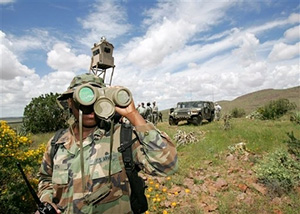 |
 |
 |
 News from Around the Americas | September 2006 News from Around the Americas | September 2006  
9/11 Changed Border
 Lynn Brezosky - Associated Press Lynn Brezosky - Associated Press


| | Georgia National Guardsman Pfc. Jeremy Smith, from Warner Robins, Ga., scans the horizon at an Entry Identification Team station at Monument 32 along the U.S.-Mexico border near Deming, N.M., Wednesday, Aug. 30, 2006. (AP/Ric Feld) |
Brownsville, TX - Fatigue-wearing National Guard members stand by in the inspection bays. Mexican boys peddle sweets to a new market of backed-up motorists. Fewer Mexican students cross the border for English lessons at the university, just a city block into Texas.

Five years later, the outcome of the Sept. 11, 2001, terrorist attacks is visible here on the international bridges.

And it's felt in the way many in the almost binational region at the tip of South Texas have seen the back-and-forth part of their culture threatened, if not shut down.

Up until Feb. 2, 1848, the Rio Grande Valley was Mexico, and it wasn't until the 1930s that highways were cut through hundreds of miles of ranch land to link the region with Anglo Texas and the rest of the United States. Even a few decades ago, trips to "the city" meant Matamoros or Reynosa, Mexico.

Until Sept. 11, 2001, both Americans and Mexicans could go to and from the other side within a lunch hour. Customs and immigration agents were fewer and more lenient than they are today.

Border agents see themselves on the front line of homeland security, with every entrant not just a possible visa violator but a potential terrorist.

"Before 9/11, the priority was detecting narcotics, and of course, illegal immigrants," said Rick Pauza, spokesman for the new Customs and Border Protection agency. "Our primary mission became to deter the entry of terrorists and weapons of mass destruction."

Meanwhile, illegal immigration came to symbolize the porous border and U.S. vulnerability. For border crossers, it's meant the line through Customs can stall at any time as a CBP officer asks questions to determine whether a foreigner should be further questioned. Word has spread among foreigners that a CBP officer can revoke their $100 laser visas on suspicion they don't intend to return home when the visa expires. CBP officers are on the lookout for document fraud.

Wait times to cross into the United States can vary from as little as 15 minutes to an hour or more.

"I think it would be fair to say that pre-9/11 the area of the border that I know of was fairly laid-back," University of Texas-Brownsville anthropologist Tony Zavaleta said.

"In the post-9/11 world that's changed. The reality of the border is that it's much more serious. ... It's an interesting activity when you come back and you're asked your citizenship and you're challenged," he said.

Immigrant advocates like the Rev. Mike Seifert, who ministers to a poor church in Brownsville and an even poorer church across the Rio Grande in Matamoros say the war against terror has somehow morphed into a national hysteria about immigration, with the victims being the poor along the border.

Illegal immigrants working as maids in his parish earning $100 a week haven't seen children in Mexico in years, because smugglers' fees are higher now that they have to combat tighter security. Others have been jailed after returning for a family funeral. They always come back for that $100-a-week job, he said, but each time the trip gets more dangerous.

"It's like Homer's Odyssey each time - just to earn $100 a week," Seifert said.

At UT-Brownsville it means the campus's language institute is no longer packed with "walk-across" students from Mexico using the short-term rather than student visas to go to classes.

Before Sept. 11, the institute had nearly 1,500 students enrolled, Zavaleta said. Since then, enrollment has been as low as 200, with students saying they are afraid inspectors will seize their visas.

"Everybody knew they were doing it, and it was ignored," Zavaleta said. "Afterward that was enforced, and it is enforced today. There's a certain fear factor that didn't exist before. ... The word runs through the community, and then we're afraid to do this or to go there or to go to school." | 
 | |
 |



